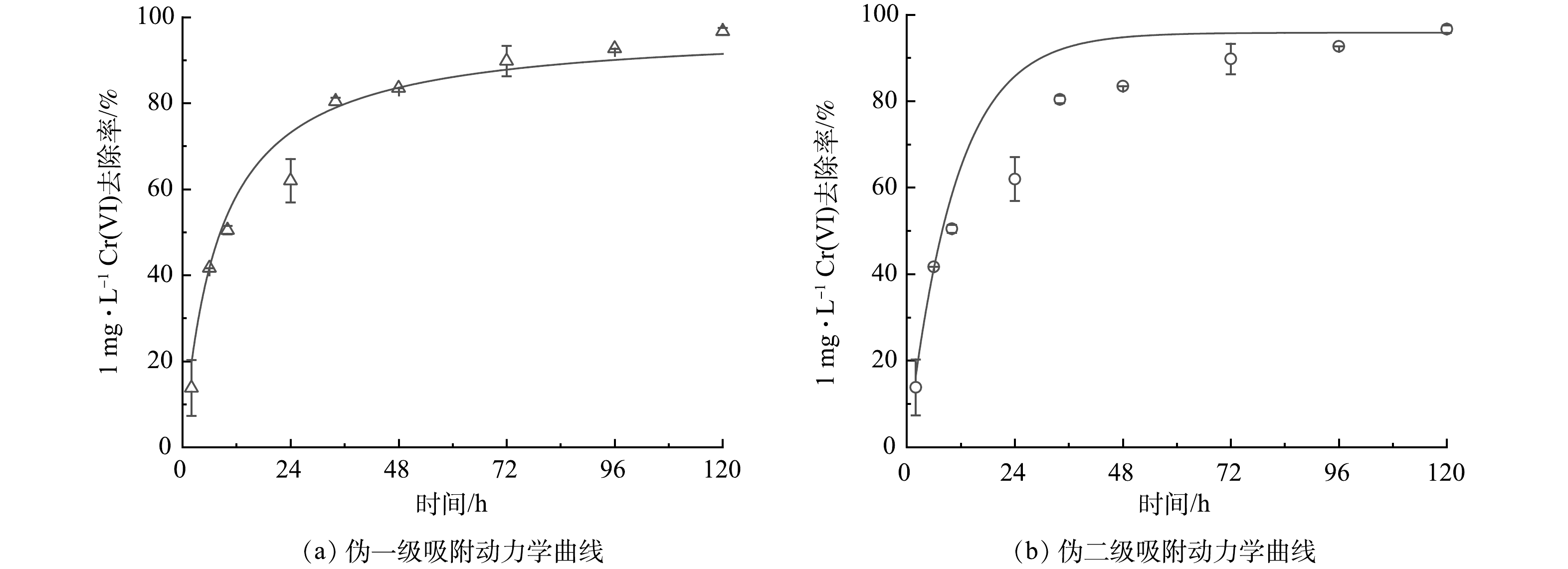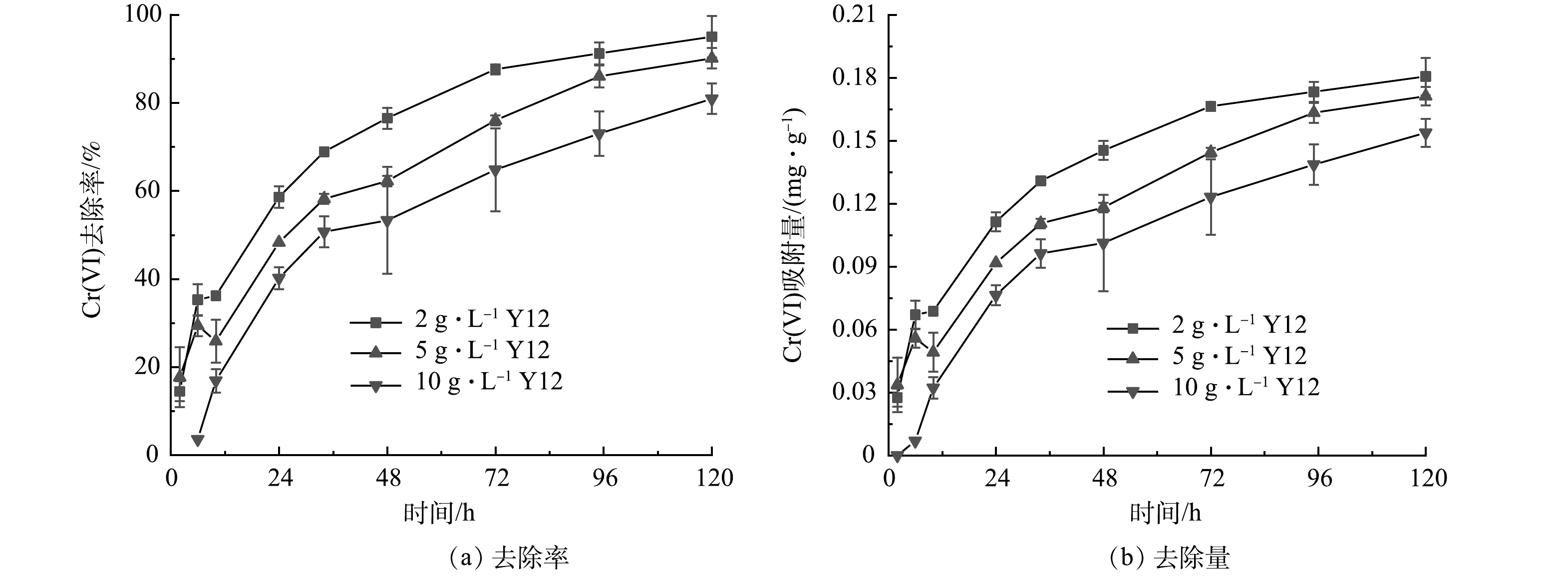-
重金属和抗生素污染治理是近几年的研究热点之一。重金属污染主要来源于冶金、电子、农药等行业,具有高毒性、无法降解等特点[1-2]。我国每年有成千上万吨抗生素被用于养殖业和医疗中,其中磺胺类药物(sulfonamide antibiotics, SAs)因其广谱性和质优价廉的优点被广泛使用[3],然而大部分抗生素并不能完全被机体吸收。有研究表明,高达85%~90%抗生素以原药或代谢物形式经排泄物进入环境,对土壤和水体造成严重污染[4]。因此,有效去除磺胺类药物及其代谢产物成为亟需解决的难题。
微生物吸附法能去除多种重金属和难降解有机污染物,且成本较低,应用前景广泛[5]。但微生物在应用时易流失,影响效果,因此,有必要将其固定化处理,提高其活性和抗逆性,延长寿命[6-9]。常用的固定化方法有吸附、交联、包埋以及复合固定法。其中包埋法稳定性高、包菌量大、且对微生物影响较小[10-11]。目前已有通过固定化处理提高微生物处理能力的研究报道。BATOOL等[12]将外生菌属(Exigubacterium sp.)制成固定化小球,发现其对Cr(Ⅵ)的去除率高于85%;而昝逢宇等[13]的研究结果表明,将啤酒酵母固定化后对Cu2+和Cd2+的吸附效果优于未固定的情况。诸多研究表明,固定化处理能提高微生物吸附剂的机械强度,并增强微生物对重金属的耐受能力[14-15]。
木屑表面含有大量的羟基、羧基等官能团,能通过离子交换和氢键吸附作用固定有机污染物和重金属[16-17],在物理结构上具有孔隙率高、比表面积大等特点,能与金属离子发生物理吸附[18],且银叶金合欢木屑属于园林废物,其来源广、可生物降解、环境友好,是固定化微生物载体理想材料之一。本研究选用枯枝落叶作为吸附剂载体材料,不仅低碳环保,也为园林废弃物的资源化利用提供新思路。课题组前期从环境中筛选获得一株菌株,其对重金属Cr(Ⅵ)和SAs同时具有较好耐受和吸附效果。为提高此菌株实际应用价值,本研究采用包埋法将其制备成固定化微生物吸附剂,探讨了其对重金属Cr(Ⅵ)和常见SAs的吸附性能,且进一步将吸附剂应用于电镀废水处理中,以期为水体重金属Cr(Ⅵ)和SAs污染治理提供参考。
-
从广州市某污水处理厂的剩余污泥中筛选、分离得到的一株对重金属具有较好吸附效果且能耐受SAs的菌株,经鉴定为伯克氏菌属(Burkholderia sp.),编号Y12[19]。
-
营养培养基:3 g牛肉膏,10 g蛋白胨,5 g NaCl,1 000 mL水,在121 ℃下于高压灭菌锅处理30 min。
海藻酸钠、CaCl2、二苯碳酰二肼(C13H14N4O)、甲醇(G.R.)、甲酸(G.R.)、乙腈(G.R.)等。Cr(Ⅵ)标液(1 000 mg·L−1,accuStandard);磺胺嘧啶(sulfadiazine, SZ)、磺胺甲嘧啶(sulfamerazine, SMZ)、磺胺甲噁唑(sulfamethoxazole, SMX)均选用Dr. Ehrenstorfer GmbH(德国)。
抗生素标准母液的配制:分别称取一定量的SZ/SMZ/SMX于棕色容量瓶中,用色谱纯甲醇溶解,定容,配置成100 mg·L−1的SZ/SMZ/SMX标准溶液,4 ℃冰箱保存备用。
实验木屑的制备:取银叶金合欢(Acacia podalyriifolia)的枯枝,用蒸馏水洗净,烘干后研磨,筛分,取过60目以上的木屑,用无菌塑封袋保存备用。
-
1)菌株的扩大培养。取Y12菌种子液,按1%(体积比)接种量接种到已灭菌的营养液培养基中,于30 ℃,150 r·min−1恒温摇床扩大培养24~36 h,待用。
2)菌悬液的制备。将活化的菌液于25 ℃、6 000 r·min−1离心6 min,弃上清液,用无菌水洗涤菌体(25 ℃,6 000 r·min−1,6 min)2~3次后收集菌体,用无菌水重悬,配置成相应质量浓度的菌悬液,备用。
3)吸附剂的制备。包埋法制备固定化微生物吸附剂SY12。取蒸馏水加热至50 ℃左右,边搅边加入海藻酸钠至全部溶解,稍微冷却后,加入木屑载体搅匀,冷却至室温后加入菌悬液,搅均,再将混合液均匀滴入4%CaCl2交联剂中,形成小球状的固定化微生物吸附剂,置于4 ℃下交联24 h后保存备用。经过测定,包埋菌株后的SY12平均质量为2.63 g。
-
1)吸附剂对SAs的吸附。分别在含有5 mg·L−1 SZ/SMZ/SMX的体系中加入100颗SY12反应;另外,分别将含有SAs体系pH调整为3、7和11,加入SY12反应,分别于2、10、24、48、72 h取样,测定SAs残留量。
2)吸附剂对Cr(Ⅵ)的吸附。分别考察Cr(Ⅵ)初始浓度(1、5、10、20、50 mg·L−1)、含菌量(0、2、5和10 g·L−1)和载体处理方式(冻干/热干燥)对吸附剂去除Cr(Ⅵ)的影响。SY12投加量为100颗,溶液pH为5.5~6.5,分别于2、6、10、24、36、48、72、96、120 h取样,测定Cr(Ⅵ)残留量。
3) 吸附剂对Cr(Ⅵ)-SAs复合污染的吸附去除。分别设置不同SAs(SZ/SMZ/SMX,3 mg·L−1)和Cr(Ⅵ) (1 mg·L−1)的复合污染体系,加入一定量SY12反应,分别于2、10、24、48和72 h取样,测定SZ/SMZ/SMX和Cr(Ⅵ)残余浓度。所有样品均置于25 ℃,150 r·min−1摇床中反应,以不加吸附剂体系为空白对照,每组做2个平行样。
-
为探究吸附剂对污染物吸附动力学规律,引入伪一级动力学模型(式(1))和伪二级动力学模型(式(2))。
式中:qt和qe分别是在时间t和平衡时的去除量;k1和k2分别是伪一级和伪二级动力学方程的反应速率常数。
-
取东莞市某电镀厂电镀废水为实验材料,经分析,碱性含铬废水和酸性含铬废水中Cr(Ⅵ)初始质量浓度分别为17.8 mg·L−1和229.5 mg·L−1,初始pH为10.3和2.8。
制备SY12,分别往80 mL各类电镀废水中放入100颗SY12进行吸附反应。于2、6、10、24、36、48、72、96、120 h取样,过滤,测定溶液中残余Cr(Ⅵ)浓度。
-
1) SAs的测定。溶液中残留SAs用高效液相色谱仪(HPLC,LC - 20A,Shimadzu Japan)测定。分析条件:C18反相柱(4.6 mm×250 mm, 5 μm, Thermo Fisher Scientific),柱温30 ℃,流动相为0.1%甲酸水:乙腈= 30%:70%(体积比),流速为1.0 mL·min−1,进样量为20 μL,紫外检测波长为270 nm[20]。使用二苯碳酰二肼分光光度法测定溶液中的Cr(Ⅵ)含量;用火焰原子吸收光谱法测定溶液中的总Cr含量。
2)去除率根据式(3)进行计算,吸附量根据式(4)进行计算。
式中:η为SAs或金属离子的去除率,%;Ce为空白体系中SAs或金属离子的质量浓度,mg·L−1;C1为反应体系中SAs或金属离子的残余质量浓度,mg·L−1。
式中:q为吸附量,mg·g−1;ce为空白体系中污染物质量浓度,mg·L−1;V为体系体积,L;c为吸附后体系中污染物质量浓度,mg·L−1;m为投加吸附剂平均质量,g。
-
由图1(a)~(b)可知,吸附剂对SAs的去除率先快速增长,然后趋于平缓,达到吸附平衡[21]。整体来看,吸附剂对SMZ和SZ的去除效果均优于SMX,在72 h时SY12对5 mg·L−1 SZ和SMZ的去除率分别为47.9%和35.0%,吸附量分别为0.091 mg·g−1和0.067 mg·g−1。这可能是因为随着SAs质量浓度的提高,扩散速率增加,SY12上能与SAs相结合的有效吸附点位被充分利用,导致吸附量有所上升。
根据表1和图1(c)可见,伪二级动力学方程能更好地描述SY12对SMZ、SMX和SZ的吸附动力学过程,说明整个吸附过程受控于化学吸附[22]。这主要是因为在吸附过程中,吸附剂对不同SAs的吸附效果与SAs的化学结构和官能团有关[23]。SAs化合物同时含有酸性磺胺基团和碱性氨基,分子结构随着溶液pH变化而发生变化,参与吸附的官能团活性点位也随之发生变化[24]。SMZ、SMX和SZ的pKa分别为4.51、5.73和6.47[25-26],由于SAs在水溶液中水解后以离子化磺胺形式存在。有研究表明,木屑的等电点是3.2,主要带电官能团是-COO[27],同时,SMZ的pKa较低,电离程度较大,SY12对其的吸附效果较好。这与谢胜等[25]的研究结果相似。
-
分别在酸性(pH=3)、中性(pH=7)和碱性(pH=11)条件下考察了SY12对SAs的吸附性能,结果如图2所示。由图2可见,对于SMZ和SZ而言,中性条件下吸附效果最佳,而过酸或过碱会抑制SY12对SMZ和SZ的吸附效果。这是因为pH不仅影响SAs的存在形态,而且影响吸附剂表面官能团的解离程度,此外,强酸强碱也不利于微生物活性,从而导致SMZ和SZ的吸附效果较差[14]。而对于SMX而言,当溶液pH为3时,SMX主要以不带电荷的中性分子存在;而随着pH的增大,中性分子比例逐渐下降,阴离子形态比例上升。而木屑表面在pH为3时呈正电性,在中性或碱性中呈现负电性,说明在pH为3时SY12对SMX的去除效果不可能是因为静电作用,但随着pH的升高,SY12对SMX的低去除率便可能是因为SY12表面的负电荷与SMX阴离子之间的静电排斥作用[28],这也与其他研究者的结论相似[29]。综上所述,中性条件下SY12对SMZ和SZ的吸附效果最佳;酸性条件下SMX的吸附效果更佳。因此,在实际应用中处理酸性或碱性废水时,需先进行稀释、酸碱中和(废碱渣中和酸性废水或酸、碱废水相互中和)等预处理,使废水处于中性条件后再进行吸附去除。
-
1)吸附剂对Cr(Ⅵ)的吸附动力学。为了解吸附速率和吸附限速步骤,对SY12吸附1 mg·L−1 Cr(Ⅵ)的过程进行吸附动力学分析。由图3(a)~(b)可以看出,拟合曲线均呈现迅速增长而后逐渐平稳,符合各类多孔结构吸附剂的吸附规律。利用伪一级动力学方程和伪二级动力学方程对数据进行拟合,结果如表2所示。结果表明,SY12对Cr(Ⅵ)的吸附过程更符合伪二级动力学模型(R2>0.99)。由此可知,SY12吸附Cr(Ⅵ)的限速步骤为化学吸附,如化学键的形成[14, 18]。
2)吸附剂对不同浓度Cr(Ⅵ)的吸附。图4是吸附剂在120 h内对不同质量浓度Cr(Ⅵ)的吸附情况。如图4(a)所示,随着时间延长,吸附剂对不同质量浓度Cr(Ⅵ)的去除率呈上升趋势,但是随着Cr(Ⅵ)质量浓度的升高去除率反而降低,SY12对1 mg·L−1 Cr(Ⅵ)的去除率最高,在120 h时达96.7%。吸附剂SY12对Cr(Ⅵ)的吸附作用包括载体吸附、重金属在载体上的扩散和传质,以及微生物的吸附和交换作用[30-32],载体表面的功能基团如羟基、羧基等能与Cr(Ⅵ)结合形成共价键或离子键,进而使Cr(Ⅵ)从液相中脱离[33]。由图4(a)~(b)可知,随着Cr(Ⅵ)质量浓度的增加,去除率逐渐降低,但吸附量增加,后期都逐渐趋于稳定;另一方面,Cr(Ⅵ)质量浓度提高,进入吸附剂内部的Cr(Ⅵ)增加,对Y12菌的抑制作用增强,吸附效果下降[34],这与其他研究者的结论一致[21, 35]。
前期研究表明,Y12能有效去除Cr(Ⅵ),当体系中同时含有Cu(Ⅱ),其还能作为氧化还原酶等多种细胞酶的激活剂起到催化作用,促进Y12对Cr(Ⅵ)的还原作用[19]。由图4(c)可知,SY12主要通过吸附作用去除Cr(Ⅵ),且总铬和Cr(Ⅵ)去除率曲线基本一致。由此可见,固定化处理后的Y12同游离菌体相比,还原性减弱,这可能是因为载体给吸附剂提供了更丰富的吸附位点,如载体上的羟基、羧基等有效官能团能更容易吸附Cr(Ⅵ),从而使固定化处理后的吸附剂主要以络合作用固定Cr(Ⅵ)。总体而言,高质量浓度Cr(Ⅵ)不利于Y12的生长,影响菌体代谢活性,进而抑制了吸附剂对Cr(Ⅵ)的吸附,而且Cr(Ⅵ)质量浓度越高,抑制性越强。这与其他研究结果一致[20, 36]。
3)不同含菌量SY12对Cr(Ⅵ)的吸附。考察不同含菌量SY12对10 mg·L−1 Cr(Ⅵ)的去除效果。如图5所示,加入2 g·L−1 Y12菌的吸附剂对Cr(Ⅵ)的吸附效果最好,吸附量为0.18 mg·g−1;随着投菌量增加,吸附量反而降低。这是因为吸附剂上的菌体主要通过表面吸附去除Cr(Ⅵ),但含菌量过高时,菌体间的相互作用力增强,菌体相互聚集成团,导致了吸附剂内部孔隙度下降,菌比表面积降低,有效吸附位点减少[37-38];另外,也可能是因为大量菌体覆盖在吸附载体表面,减少了吸附载体对Cr(Ⅵ)的吸附贡献。因此,吸附剂中的含菌量并非越高越好,这也与其他研究者的结论类似[14, 21]。后续实验中吸附剂含菌量均为2 g·L−1。
4)木屑预处理对SY12吸附Cr(Ⅵ)的影响。木屑有着独特的表面结构,既能作为载体供微生物生长附着,也能作为吸附材料。为了更好地保留木屑的表面和组织结构,选用冻干法进行干燥处理,对比研究热处理和冻干处理对吸附剂吸附性能的影响。由图6(a)可知,反应前期SY12对低质量浓度Cr(Ⅵ)(1 mg·L−1)的去除率较高,但后期对5 mg·L−1 Cr(Ⅵ)吸附效果最好。从吸附量测定结果可以看出,SY12对10 mg·L−1 Cr(Ⅵ)吸附量最高,为0.13 mg·g−1(图6(b))。与以上结果比较,冻干处理后的吸附效果下降。这可能是木屑经冻干处理后物理结构和分子结构变小,仅凭本身的多孔结构和大比表面积通过物理吸附固定Cr(Ⅵ);而热干燥处理温度较高,木屑表面变得更粗糙、束状结构更薄,孔隙结构得到改善,整体的比表面积与孔容积变大,木屑表面可用的吸附点位增加,能吸附更多Cr(Ⅵ)[2, 39-41],所以经热干燥处理的SY12对Cr(Ⅵ)的吸附性能更优。
-
由上述实验结果可知,SY12对Cr(Ⅵ)和SAs均有一定的吸附能力,但当Cr(Ⅵ) 和SAs以复合污染存在时,其吸附效果仍然未知。由图7(a)可见,在复合污染体系中,对于SMZ和SMX而言,在反应24 h内,SY12对SMZ和SMX的去除率较单一体系中的低。可见Cr(Ⅵ)的存在会对SMZ和SMX的吸附产生抑制作用,但这种阻碍作用会随着时间延长逐渐消失,在72 h的去除效果仍低于单一SAs体系。这说明Cr(Ⅵ)与SMZ和SMX之间存在竞争关系,削弱了SY12对SMZ和SMX的吸附效果。相反,在Cr(Ⅵ)存在时,SY12对SZ的去除率更高,这可能是因为SZ上的胺基较SMZ和SMX的更活泼,除了能与SY12发生反应,还能与Cr(Ⅵ)发生络合反应[42],从而进一步提高了对SZ的去除效果。
由图7(b)可知,在Cr(Ⅵ)-SAs复合污染体系中,SY12对Cr(Ⅵ)的去除率从24 h便趋于稳定,在72 h时均达到98%,吸附效果优于单一Cr(Ⅵ)体系,且提升幅度大于SAs的降低幅度,说明在复合污染体系中对Cr(Ⅵ)的吸附影响较大。结合图7(c)可知, SY12对总Cr的去除率均低于Cr(Ⅵ),表明了在该体系中SY12对Cr(Ⅵ)的去除包括了吸附和还原2个过程,这可能是Cr(Ⅵ)与SAs中的磺胺等基团发生了氧化还原作用,将部分Cr(Ⅵ)还原成了Cr(Ⅲ),进一步促进了Cr(Ⅵ)的去除。总体而言,在Cr(Ⅵ) – SAs复合污染体系中,Cr(Ⅵ) 和SAs在SY12表面的吸附存在竞争,但SY12对二者的吸附机理不同,对SAs主要是共轭吸附作用,而对Cr(Ⅵ) 的吸附主要是SY12中含氧官能团对Cr(Ⅵ) 的络合吸附作用。结果表明SY12可以用于处理Cr(Ⅵ) – SAs复合污染水体。
-
图8反映了SY12对重金属电镀废水的处理效果。由图8可知,SY12对酸性电镀废水中的Cr(Ⅵ)有较好的吸附效果,吸附量为3.7 mg·g−1;但对碱性电镀废水中的Cr(Ⅵ)吸附效果不显著,仅为0.1 mg·g−1。大量研究表明,多数微生物在酸性环境中对Cr(Ⅵ)的吸附效果更好[43]。这是由于在酸性条件下,Cr(Ⅵ)主要以CrO42-或Cr2O72-形态存在,能通过静电吸引作用跟吸附剂表面带正电荷的官能团结合,从而有较高的去除率[44]。而在碱性条件下,不溶性和聚合的氧化铬物质CrO42-和HCrO4−多以沉淀的形式存在,抑制了其在吸附剂表面的吸附[45]。SANGHI等[46]的研究结果也表明,在酸性条件下,Cr(Ⅵ)以CrO42-的形式被吸附在带正电荷的菌体细胞壁上,且pH越低,吸附性越强。
-
1)吸附剂能有效去除水体中的SMZ、SZ和SMX,第36 h达吸附平衡,且对嘧啶类SMZ和SZ的去除效果优于SMX。吸附过程受控于化学吸附;在中性条件下,SY12对SMZ和SZ的吸附效果最佳,而在酸性条件下对SMX的吸附效果更佳。
2) SY12对Cr(Ⅵ)具有较好的吸附效果,但随着Cr(Ⅵ)质量浓度提升,去除率降低;SY12在120 h时,对1 mg·L−1 Cr(Ⅵ)的去除率为96.7%,以化学吸附为主;热干燥处理能改善木屑的孔隙结构,增大比表面积和孔容积,有利于SY12对Cr(Ⅵ)的吸附。
3)在Cr(Ⅵ)-SAs复合污染体系中,SY12对SAs的吸附能力略微下降,对Cr(Ⅵ)的去除能力也有所提升。此外,SY12可用于电镀废水的处理,能有效去除酸性电镀废水中的Cr。
固定化微生物吸附剂的制备及其对六价铬和磺胺类抗生素的吸附性能
Preparation of an immobilized microbial adsorbent and its performance on the adsorption of Cr(Ⅵ) and sulfonamide antibiotics
-
摘要: 以银叶金合欢木屑为载体包埋伯克氏菌属(Burkholderia sp.,简称Y12菌)制备固定化微生物吸附剂——木屑-Y12吸附剂(SY12),考察了其对不同磺胺类抗生素和重金属Cr(Ⅵ)的吸附性能。结果表明,SY12能有效吸附水体中的磺胺甲嘧啶 (sulfamerazine, SMZ)、磺胺嘧啶(sulfadiazine, SZ)和磺胺甲噁唑(sulfamethoxazole, SMX),且对5 mg·L−1 SZ的去除率最高,为47.9%。SY12对Cr(Ⅵ)也有高效吸附效果,其中对1 mg·L−1 Cr(Ⅵ)吸附效果最佳,去除率达96.7%,吸附机制以化学吸附为主。SY12还能同时去除Cr(Ⅵ)–磺胺类药物((sulfonamide antibiotics, SAs)复合污染,但复合污染体系中,SY12对SAs的吸附能力略微下降,对Cr(Ⅵ)的去除能力却增强。此外,SY12能有效去除酸性电镀废水中的Cr;热干燥处理的木屑更有利于吸附Cr(Ⅵ)。Abstract: An immobilized microbial adsorbent was prepared through embedding Burkholderia sp. (strain Y12) in Acacia sawdust carrier,: Na-alginate immobilized sawdust and Y12 adsorbent (SY12). The performance on the adsorption of Cr(Ⅵ) and different kinds of sulfonamide antibiotics by SY12 was studied. The results showed that SY12 could effectively remove sulfamerazine (SMZ), sulfadiazine (SZ) and sulfamethoxazole (SMX) from water, of which the highest removal rate of 47.9% occurred for 5 mg·L−1 SZ. SY12 showed a high Cr(Ⅵ) removal rate, and the best adsorption appeared toward 1 mg·L−1 Cr(Ⅵ), the corresponding removal rate was 96.7%, and chemical adsorption dominated Cr(Ⅵ) removal mechanism. SY12 could also eliminate Cr(Ⅵ) – SAs composite pollution simultaneously, but in the combined pollution system, the removal capacity of SAs by SY12 slightly decreased, while the removal capacity of Cr(Ⅵ) increased. Another study indicated that SY12 could effectively remove Cr from acidic electroplating wastewater. In addition, the sawdust treated by heat drying was more conducive to Cr(Ⅵ) adsorption, and all the removal rates decreased with the increase of pollutant mass concentration.
-
Key words:
- immobilization /
- microbial adsorbent /
- heavy metals /
- antibiotics /
- composite pollution
-

-
表 1 动力学模型拟合参数
Table 1. kinetic model parameters
吸附剂 qe,exp 伪一级动力学方程 伪二级动力学方程 k1 qe R2 k2 qe R2 SMZ 0.091 0.082 0.620 0.5483 0.093 11.590 0.8356 SMX 0.055 0.046 0.367 0.9876 0.049 10.034 0.9963 SZ 0.067 0.055 0.500 0.6591 0.059 11.110 0.8017 表 2 动力学模型参数
Table 2. kinetic model parameters
吸附剂 qe,exp 伪一级动力学方程 伪二级动力学方程 k1 qe R2 k2 qe R2 SY12 96.7 0.094 95.84 0.938 2 0.001 97.56 0.998 5 -
[1] 王浩洋. 磁性壳聚糖/板栗壳纤维复合材料处理含铬废水的研究[J]. 广东化工, 2020, 47(13): 96-98. doi: 10.3969/j.issn.1007-1865.2020.13.043 [2] 刘晓凤, 徐鑫, 陈瑞锋, 等. 木屑吸附溶液中重金属离子的试验研究[J]. 太原理工大学学报, 2019, 50(4): 492-497. doi: 10.16355/j.cnki.issn1007-9432tyut.2019.04.013 [3] LIU J L, WONG M H. Pharmaceuticals and personal care products (Ppcps): A review on environmental contamination in China[J]. Environment International, 2013, 59: 208-224. doi: 10.1016/j.envint.2013.06.012 [4] RADKE M, LAUWIGI C, HEINKELE G, et al. Fate of the antibiotic sulfamethoxazole and its two major human metabolites in a water sediment test[J]. Environmental Science & Technology, 2009, 43(9): 3135-3141. [5] 刘金香, 葛玉杰, 谢水波, 等. 改性微生物吸附剂在重金属废水处理中的应用进展[J]. 微生物学通报, 2020, 47(3): 941-951. doi: 10.13344/j.microbiol.china.190507 [6] HUANG S W, CHEN X, WANG D D, et al. Bio-reduction and synchronous removal of hexavalent chromium from aqueous solutions using novel microbial cell/algal-derived biochar particles: Turning an environmental problem into an opportunity[J]. Bioresource Technology, 2020, 309: 123304. doi: 10.1016/j.biortech.2020.123304 [7] CATANIA V, LOPRESTI F, CAPPELLO S, et al. Innovative, ecofriendly biosorbent-biodegrading biofilms for bioremediation of oil- contaminated water[J]. New Biotechnology, 2020, 58(25): 25-31. [8] DZIONEK A, WOJCIESZYNSKA D, GUZIK U. Natural carriers in bioremediation: A review[J]. Electronic Journal of Biotechnology, 2016, 23: 28-36. doi: 10.1016/j.ejbt.2016.07.003 [9] 黄真真, 陈桂秋, 曾光明, 等. 固定化微生物技术及其处理废水机制的研究进展[J]. 环境污染与防治, 2015, 37(10): 77-85. doi: 10.15985/j.cnki.1001-3865.2015.10.015 [10] 王广金, 褚良银, 杨平, 等. 固定化微生物技术及其在废水处理中的应用[J]. 重庆环境科学, 2003(12): 171-173. [11] 高华崇, 乔丽丽, 尹莉, 等. 包埋微生物固定化载体的结构性能研究[J]. 能源环境保护, 2017, 31(1): 29-33. doi: 10.3969/j.issn.1006-8759.2017.01.009 [12] BATOOL R, QURRAT-UL-AIN K, NAEEM A. Comparative study of Cr(VI) removal by Exiguobacterium sp. in free and immobilized forms[J]. Bioremediation Journal, 2014, 18(4): 317-327. doi: 10.1080/10889868.2014.938722 [13] 昝逢宇, 霍守亮, 席北斗, 等. 非固定化和固定化啤酒酵母对Cd(Ⅱ)和Cu(Ⅱ)的吸附特性研究[J]. 环境工程学报, 2011, 5(11): 2473-2480. [14] 余关龙, 彭海渊, 王世涛, 等. 固定化生物吸附剂对Cd(Ⅱ)的去除性能及机理[J]. 化工进展, 2021, 40(5): 2882-2892. doi: 10.16085/j.issn.1000-6613.2020-1258 [15] TSEKOVA K, TODOROVA D, DENCHEVA V, et al. Biosorption of copper(II) and cadmium(II) from aqueous solutions by free and immobilized biomass of Aspergillus Niger[J]. Bioresource Technology, 2010, 101(6): 1727-1731. doi: 10.1016/j.biortech.2009.10.012 [16] SIDIRAS D, BATZIAS F, SCHROEDER E, et al. Dye adsorption on autohydrolyzed pine sawdust in batch and fixed-bed systems[J]. Chemical Engineering Journal, 2011, 171(3): 883-896. doi: 10.1016/j.cej.2011.04.029 [17] 张汝壮. 功能化改性木屑材料的制备及其吸附/光催化性能研究[D]. 上海: 华东理工大学, 2015. [18] 马迎春. 固定化生物吸附剂对重金属铜的吸附性能研究[D]. 长沙: 湖南大学, 2013. [19] 檀笑, 曾洁仪, 张逸凡, 等. 一株典型伯克氏菌对Cr(Ⅵ)/Cu(Ⅱ)复合污染的吸附转化[J]. 环境污染与防治, 2019, 41(08): 932-937. doi: 10.15985/j.cnki.1001-3865.2019.08.013 [20] 曾洁仪, 曾苏杭, 纪梦钿, 等. Sakaguchia Cladiensis对磺胺甲嘧啶/铜复合污染中抗生素的降解[J]. 中国环境科学, 2019, 39(12): 5293-5300. [21] 文晓凤, 杜春艳, 袁瀚宇, 等. 改性磁性纳米颗粒固定内生菌Bacillus Nealsonii吸附废水中Cd(Ⅱ)的特性研究[J]. 环境科学学报, 2016, 36(12): 4376-4383. [22] 赵涛, 蒋成爱, 丘锦荣, 等. 皇竹草生物炭对水中磺胺类抗生素吸附性能研究[J]. 水处理技术, 2017, 43(4): 56-61. doi: 10.16796/j.cnki.1000-3770.2017.04.013 [23] ZHOU A X, ZHANG Y L, LI R, et al. Adsorptive removal of sulfa antibiotics from water using spent mushroom substrate, an agricultural waste[J]. Desalination and Water Treatment, 2016, 57(1): 388-397. [24] BAJPAI A K, RAJPOOT M, MISHRA D D. Studies on the correlation between structure and adsorption of sulfonamide compounds[J]. Colloids And Surfaces A:Physicochemical And Engineering Aspects, 2000, 168(3): 193-205. [25] 谢胜, 李娟英, 赵庆祥. 磺胺类抗生素的活性炭吸附过程研究[J]. 环境工程学报, 2012, 6(2): 483-488. [26] TAPPE W, ZARFL C, KUMMER S, et al. Growth-inhibitory effects of sulfonamides at different pH: Dissimilar susceptibility patterns of a soil bacterium and a test bacterium used for antibiotic assays[J]. Chemosphere, 2008, 72(5): 836-843. doi: 10.1016/j.chemosphere.2008.02.041 [27] 吕慧峰, 翟建平, 李琴, 等. 水杉锯末对三价铬离子的吸附机理研究[J]. 环境科学与技术, 2007(8): 24-25. doi: 10.3969/j.issn.1003-6504.2007.08.009 [28] 俞伟, 赵思钰, 王宇航, 等. 苜蓿生物炭对磺胺甲恶唑的吸附机理研究[J]. 西北大学学报(自然科学版), 2022, 52(1): 115-127. doi: 10.16152/j.cnki.xdxbzr.2022-01-014 [29] ZHENG H, WANG Z Y, ZHAO J, et al. Sorption of antibiotic sulfamethoxazole varies with biochars produced at different temperatures[J]. Environmental Pollution, 2013, 181: 60-67. doi: 10.1016/j.envpol.2013.05.056 [30] 李猛, 张鸿郭, 周子倩, 等. 固定化Srb处理低浓度含铬废水[J]. 环境工程, 2016, 34(4): 20-24. doi: 10.13205/j.hjgc.201604005 [31] 赵锐. 耐Cr(Ⅲ)微生物的固定化及吸附Cr(Ⅲ)的特性研究[D]. 西安: 陕西科技大学, 2019. [32] JING R, KJELLERUP B V. Biogeochemical cycling of metals impacting by microbial mobilization and immobilization[J]. Journal Of Environmental Sciences (China), 2018, 66: 146-154. doi: 10.1016/j.jes.2017.04.035 [33] MA P, ZHANG D. Immobilized lentinus edodes residue as absorbent for the enhancement of cadmium adsorption performance[J]. Frontiers of Environmental Science & Engineering, 2012, 6(4): 498-508. [34] ZHOU W Z, LIU D S, ZHANG H O, et al. Bioremoval and recovery of cd(II) by pseudoalteromonas sp. SCSE709-6: Comparative study on growing and grown cells[J]. Bioresource Technology, 2014, 165: 145-151. doi: 10.1016/j.biortech.2014.01.119 [35] TODOROVA K, VELKOVA Z, STOYTCHEVA M, et al. Novel composite biosorbent from bacillus cereus for heavy metals removal from aqueous solutions[J]. Biotechnology, Biotechnological Equipment, 2019, 33(1): 730-738. doi: 10.1080/13102818.2019.1610066 [36] MAO F, LIU X H, WU K, et al. Biodegradation of sulfonamides by shewanella oneidensis Mr-1 and shewanella sp strain Mr-4[J]. Biodegradation, 2018, 29(2): 129-140. doi: 10.1007/s10532-017-9818-5 [37] OZDEMIR S, KILINC E, POLI A, et al. Biosorption of Cd, Cu, Ni, Mn and Zn from aqueous solutions by thermophilic bacteria, Geobacillus toebii sub. sp decanicus and Geobacillus thermoleovorans sub. sp stromboliensis: Equilibrium, kinetic and thermodynamic studies[J]. Chemical Engineering Journal, 2009, 152(1): 195-206. doi: 10.1016/j.cej.2009.04.041 [38] SHENG P X, WEE K H, TING Y P, et al. Biosorption of copper by immobilized marine algal biomass[J]. Chemical Engineering Journal, 2008, 136(2-3): 156-163. doi: 10.1016/j.cej.2007.03.033 [39] 常帅帅, 张学杨, 王洪波, 等. 木屑生物炭的制备及其对Pb(Ⅱ)的吸附特性研究[J]. 生物质化学工程, 2020, 54(3): 37-44. doi: 10.3969/j.issn.1673-5854.2020.03.006 [40] ALI R M, HAMAD H A, HUSSEIN M M, et al. Potential of using green adsorbent of heavy metal removal from aqueous solutions: Adsorption kinetics, isotherm, thermodynamic, mechanism and economic analysis[J]. Ecological Engineering, 2016, 91: 317-332. doi: 10.1016/j.ecoleng.2016.03.015 [41] KRISHNAN K A, ANIRUDHAN T S. A preliminary examination of the adsorption characteristics of Pb(II) ions using sulphurised activated carbon prepared from bagasse pith[J]. Indian Journal of Chemical Technology, 2002, 9(1): 32-40. [42] WALLIS S C, GAHAN L R, CHARLES B G, et al. Copper(II) complexes of the fluoroquinolone antimicrobial ciprofloxacin. Synthesis, x-ray structural characterization, and potentiometric study[J]. Journal of Inorganic Biochemistry, 1996, 62(1): 1-16. doi: 10.1016/0162-0134(95)00082-8 [43] 宋洁. 铬(Ⅵ)的微生物转化研究进展[J]. 生物学教学, 2015, 40(2): 43-44. [44] MOHANTY K, JHA M, MEIKAP B C, et al. Biosorption of Cr(VI) from aqueous solutions by eichhornia crassipes[J]. Chemical Engineering Journal (Lausanne, Switzerland:1996), 2006, 117(1): 71-77. [45] LAKSHMI S, SUVEDHA K, SRUTHI R, et al. Hexavalent chromium sequestration from electronic waste by biomass of aspergillus carbonarius[J]. Bioengineered, 2020, 11(1): 708-717. doi: 10.1080/21655979.2020.1780828 [46] SANGHI R, SANKARARAMAKRISHNAN N, DAVE B C. Fungal bioremediation of chromates: Conformational changes of biomass during sequestration, binding, and reduction of hexavalent chromium ions[J]. Journal of Hazardous Materials, 2009, 169(1-3): 1074-1080. doi: 10.1016/j.jhazmat.2009.04.056 -




 下载:
下载:








